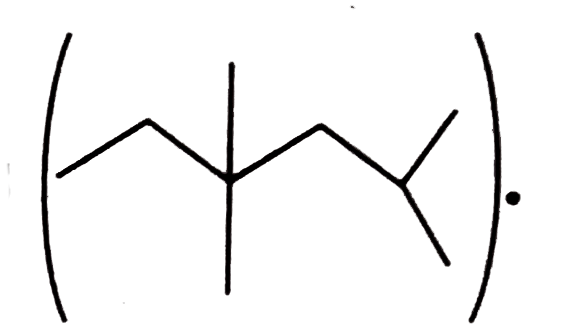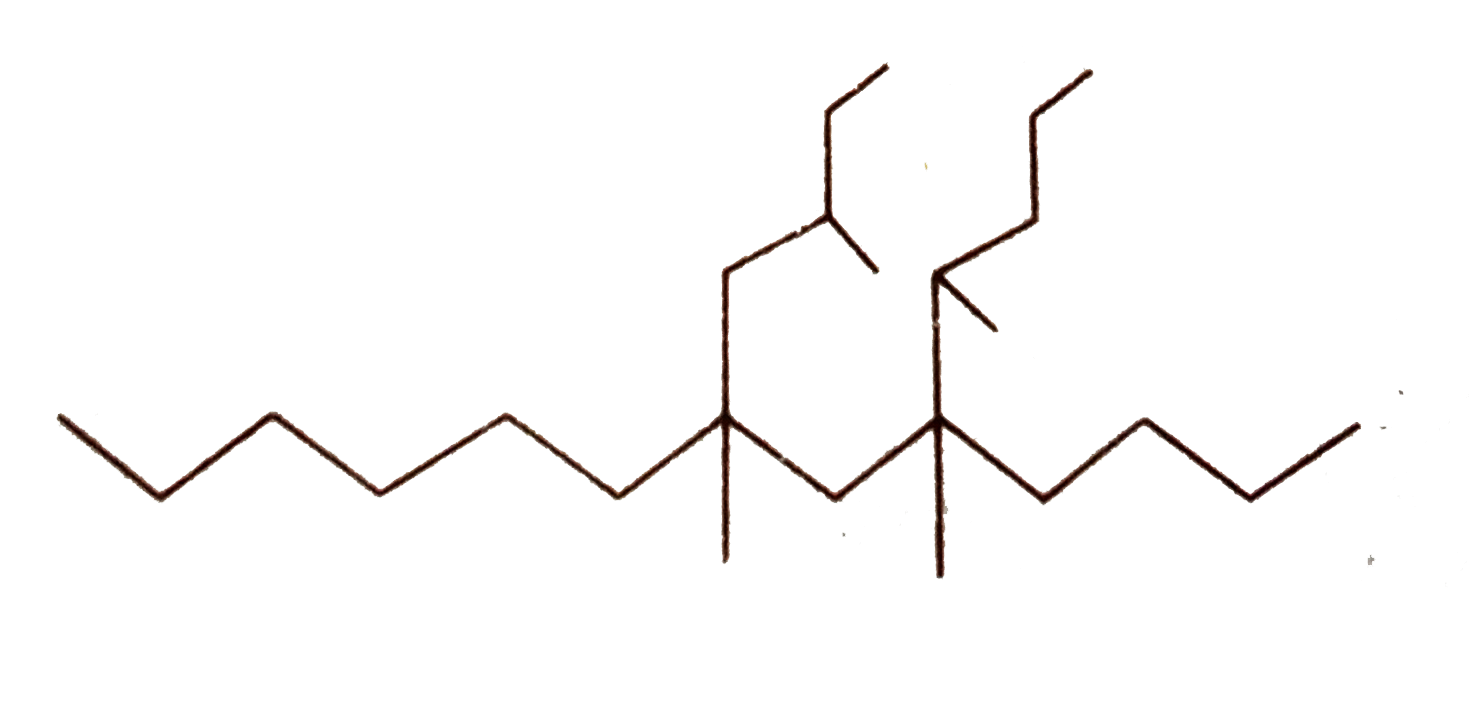Write the structure (s) of the simplest alkane (s), with fewest number of C atoms, possessing 1∘,2∘,3∘, and 4∘C atoms.
To solve the question of writing the structures of the simplest alkanes with the fewest number of carbon atoms that possess primary, secondary, tertiary, and quaternary carbon atoms, we can follow these steps:
Step 1: Understand the Types of Carbon Atoms
- Primary Carbon (1°): A carbon atom bonded to one other carbon atom.
- Secondary Carbon (2°): A carbon atom bonded to two other carbon atoms.
- Tertiary Carbon (3°): A carbon atom bonded to three other carbon atoms.
- Quaternary Carbon (4°): A carbon atom bonded to four other carbon atoms.
Step 2: Determine the Minimum Number of Carbon Atoms Required
To have at least one of each type of carbon atom (primary, secondary, tertiary, and quaternary), we need to arrange the carbon atoms in such a way that they fulfill these requirements. The simplest structure that can accommodate all these types is pentane (5 carbon atoms).
Step 3: Draw the Structure
1. Start with a straight-chain alkane (pentane).
2. Identify the carbon atoms:
- C1: Primary (CH3)
- C2: Secondary (CH2)
- C3: Tertiary (C)
- C4: Quaternary (C)
- C5: Primary (CH3)
A possible structure can be represented as follows:
CH3|CH3−CH−CH−CH2−CH3|CH3
In this structure:
- The leftmost carbon (C1) and the rightmost carbon (C5) are primary.
- The second carbon (C2) is secondary.
- The third carbon (C3) is tertiary.
- The fourth carbon (C4) is quaternary.
Step 4: Naming the Compound
Using IUPAC nomenclature, we can name this compound:
- The longest carbon chain has 5 carbons (pentane).
- The substituents on the tertiary carbon are two methyl groups (CH3).
- Therefore, the name is 2,2,3-trimethylpentane.
Step 5: Alternative Structures
We can create variations by changing the positions of the substituents while maintaining the types of carbon atoms. Here are a couple of examples:
1. 2,2,4-trimethylpentane
2. 2,3,3-trimethylpentane
Final Answer
The simplest alkanes with the fewest number of carbon atoms that possess primary, secondary, tertiary, and quaternary carbon atoms can be represented as:
1. 2,2,3-trimethylpentane
2. 2,2,4-trimethylpentane
3. 2,3,3-trimethylpentane
- Primary Carbon (1°): A carbon atom bonded to one other carbon atom.
- Secondary Carbon (2°): A carbon atom bonded to two other carbon atoms.
- Tertiary Carbon (3°): A carbon atom bonded to three other carbon atoms.
- Quaternary Carbon (4°): A carbon atom bonded to four other carbon atoms.
To have at least one of each type of carbon atom (primary, secondary, tertiary, and quaternary), we need to arrange the carbon atoms in such a way that they fulfill these requirements. The simplest structure that can accommodate all these types is pentane (5 carbon atoms).
1. Start with a straight-chain alkane (pentane).
2. Identify the carbon atoms:
- C1: Primary (CH3)
- C2: Secondary (CH2)
- C3: Tertiary (C)
- C4: Quaternary (C)
- C5: Primary (CH3)
CH3|CH3−CH−CH−CH2−CH3|CH3
In this structure:
- The leftmost carbon (C1) and the rightmost carbon (C5) are primary.
- The second carbon (C2) is secondary.
- The third carbon (C3) is tertiary.
- The fourth carbon (C4) is quaternary.
Using IUPAC nomenclature, we can name this compound:
- The longest carbon chain has 5 carbons (pentane).
- The substituents on the tertiary carbon are two methyl groups (CH3).
- Therefore, the name is 2,2,3-trimethylpentane.
We can create variations by changing the positions of the substituents while maintaining the types of carbon atoms. Here are a couple of examples:
1. 2,2,4-trimethylpentane
2. 2,3,3-trimethylpentane
The simplest alkanes with the fewest number of carbon atoms that possess primary, secondary, tertiary, and quaternary carbon atoms can be represented as:
1. 2,2,3-trimethylpentane
2. 2,2,4-trimethylpentane
3. 2,3,3-trimethylpentane
Topper's Solved these Questions
- CLASSIFICATION AND NOMENCLATURE OF ORGANIC COMPOUNDSBOOK - CENGAGE CHEMISTRY ENGLISHCHAPTER - CLASSIFICATION AND NOMENCLATURE OF ORGANIC COMPOUNDSEXERCISE - Exercises
10 Videos
- CLASSIFICATION AND NOMENCLATURE OF ORGANIC COMPOUNDSBOOK - CENGAGE CHEMISTRY ENGLISHCHAPTER - CLASSIFICATION AND NOMENCLATURE OF ORGANIC COMPOUNDSEXERCISE - Concept Application Type
7 Videos
- CLASSIFICATION AND NOMENCLATURE OF ORGANIC COMPOUNDSBOOK - CENGAGE CHEMISTRY ENGLISHCHAPTER - CLASSIFICATION AND NOMENCLATURE OF ORGANIC COMPOUNDSEXERCISE - Analytical and Descriptive Type
3 Videos
- CHEMICAL EQUILIBRIUMBOOK - CENGAGE CHEMISTRY ENGLISHCHAPTER - CHEMICAL EQUILIBRIUMEXERCISE - Subjective type
1 Videos
- GENERAL ORGANIC CHEMISTRYBOOK - CENGAGE CHEMISTRY ENGLISHCHAPTER - GENERAL ORGANIC CHEMISTRYEXERCISE - Analytical and Descriptive
1 Videos
Similar Questions
(a) Write the IUPAC name of the compound (A) whose bond line structre is

(b) Write the condensed formula of the compound (A).
(c) Define and identify all the primary (1∘), secondary (2∘), tertiary (3∘), and quaternary (4∘) carbon atoms.
(d) Identify all the 1∘,2∘, and 3∘ H atoms.
(e) Given the number of H atoms bonded to 1∘,2∘,3∘, and 4∘ C atom in an alkane.
(f) Given the number of C atoms bonded to 1∘,2∘,3∘, and 4∘ C atoms bonded to 1∘,2∘,3∘, and 4∘ C atom in an alkane.
View SolutionWrite the Lewis structures of a fluorine atom and a fluorine molecule (the atomic number of F is 9).
View Solution
Knowledge Check
The central C-atom of a carbanion possesses
Asectet of electronsBoctet of electronsCduplet of electronsDnone of these
What are the hybrid states of C atoms in alkanes, alkenes and alkynes?
View SolutionThe structue of alkane or cycloalkane with molecular formula C8H18 that has only 1∘ H atoms is:
View SolutionHow do alkanes and alkenes with same number of C atoms differ with respect to the Number of H atoms
View SolutionExplain why Alkanes with odd number of carbon atoms possess lower boiling points than those having even number of carbon atoms
View SolutionNumber of carbon atom present linearly in C3O2 :-
View SolutionHow do alkanes and alkenes with same number of C atoms differ with respect to the Nature of bonds between carbon atoms
View Solutiona. Write the IUPAC name of the following compounds.

b. Identify 1∘ (primary), 2∘ (secondery), 3∘ (teriary), and 4∘ (quaternary) C atoms.
c. Identify all the 1∘ , 2∘ , 3∘ H atoms.
View Solution
